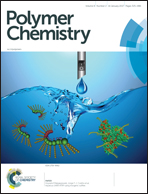Phosphonium polymers for gene delivery
Abstract
Phosphonium salt-containing polymers have very recently started to emerge as attractive materials for engineering non-viral gene delivery systems. Compared to more frequently utilised ammonium-based polymers, some of these materials can enhance binding of nucleic acids at lower polymer concentrations, and mediate good transfection efficiency, with low cytotoxicity. However, for years one of the main hurdles for their widespread application has been the lack of general routes for their synthesis. To date a range of polymerisation techniques have been explored, with the majority of them focussing on radical polymerisation, especially controlled radical polymerisation (CRP) techniques – ATRP, NMP and RAFT polymerisation – both by polymerisation of phosphonium monomers and by post-polymerisation modification of polymer intermediates. This review article aims at discussing key differences and similarities between phosphonium and other analogous cations, how these affect binding to polynucleotides, and will provide an overview of the phosphonium polymer systems that have been utilised for gene delivery.


 Please wait while we load your content...
Please wait while we load your content...